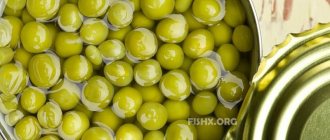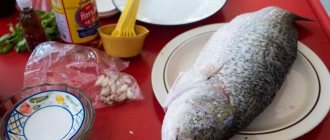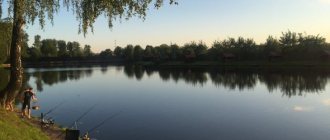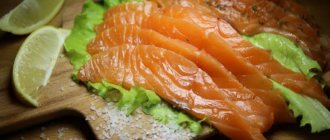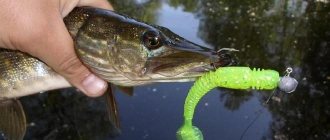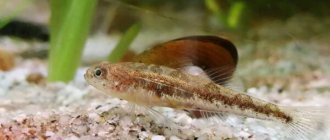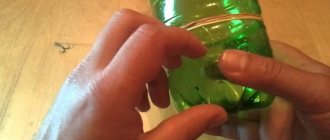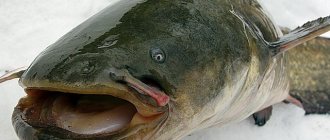Minnow fish is a very small fish that belongs to:
- to the small family;
- freshwater;
- species of the carp family;
- order of open-bellied bony fish.
The common minnow fish is quite beautiful and stands out for its brilliant rainbow colors during the spawning season. This fish grows up to 20 centimeters in length. In each of its vast habitats, it has local names: belladonna, pied, buffoon, trout, meiva, khivka. This is a schooling, highly mobile fish that can travel long distances.
Description of the minnow.
There are more than ten species of this family in the world. Let's consider two widespread ones: ordinary, lake.
Common minnow or (demoiselle minnow)
- The body is low, elongated, cylindrical, covered with barely noticeable scales, the abdomen is naked;
- fins rather short, rounded;
- the mouth is very small, semi-inferior;
- the head is small, the stigma is short, blunt;
- body length ranges from 7 to 12 centimeters;
- weight approximately 15 grams.
Lake minnow (mundushka).
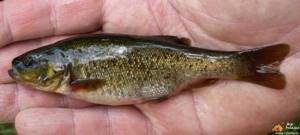
- the body is relatively tall and thick;
- covered with larger scales on the abdomen and smaller ones near the throat;
- fins short, rounded at apex, caudal fin slightly notched;
- the head is small, the stigma is short, blunt;
- the mouth is small, terminal, slightly raised upward;
- The body length of an adult reaches up to 18 centimeters;
- weight up to 100 grams.
Appearance. The color of the common minnow is a shining grayish-sand tint, with a black stripe of uncertain configuration running along the entire line of the back. The scales are very small; they are not present at all on the white abdomen. Traditionally, there are vertical spots on the sides that merge slightly below the lateral line. During spawning, the palette of the main coating becomes unusually bright and acquires the most brilliant shades. The males at this time are extremely beautiful, the fins (like the tail of a peacock) are wide and long, the color on their bases, as well as on the chest and gill covers, acquires a brilliant reddish tint. Emerald sides, shimmering with a yellowish gloss with a golden tint, the back becomes brownish-bronze. In females, the mating plumage is not very pronounced; the corners of the mouth become noticeably red, and reddish spots appear on the abdomen.
The lake species differs significantly in color from the ordinary one. The back is gray with light greenery, the sides are golden with a greenish tint, on which dark small spots spread from time to time. The fluffy dorsal and caudal fins shine emerald-gray, the pectoral and abdominal fins are sometimes orange-reddish. In females, the mating plumage is not very pronounced; the corners of the mouth become noticeably red, and red spots appear on the abdomen.
Appearance of fish
It is known that about 10 species of minnows live in reservoirs around the world, but in Russia only 2 varieties can be found. The rivers are inhabited by the common minnow . It has the following features:
- the average weight of the fish does not exceed 15 g, and the length is 10−12 cm,
- elongated body with short rounded fins,
- the scales are very small, practically absent on the stomach,
- small head and very small mouth.
In lakes and swamps you can find lake minnow . This species is similar to the river species, but has several significant differences:
- the average weight of an individual is 100 g, and the length can reach 17−19 cm,
- the body is quite tall and thick,
- the size of the scales varies from small near the head to large on the abdomen.
Both species are silver-sand in color. But the river fish has a black stripe on its back. The back of the lake species is of a rather bright emerald hue. During spawning, the color of the males changes. Large red spots appear on areas of the scales. In females, the corners of their mouths turn red.
Features of behavior:
- behaves aggressively;
- attacks, kills and eats fish that are much smaller in size;
- capable of nibbling the fins of large fish;
- brave;
- greedy;
- eats everything that floats on the water;
- has a lightning reflex;
- has excellent vision;
- subtle sense of smell.
The behavior of large flocks is more noticeably different from the behavior of small flocks. Small flocks lead a very camouflaged lifestyle, hiding under snags or in aquatic thickets. Large schools of these fish do not hide until the slightest danger appears. Moving in different directions along the current at the slightest danger, they swim away to the side with lightning speed.
In general, minnows are quite trusting and are in no hurry to hide even when they see a fisherman.
Minnow lifestyle
In lakes, the minnow sticks to shallow areas and avoids swampy shores. Spends most of the year on rocky rifts. During the pre-spawning period, it forms large aggregations consisting of individuals of similar sizes. Juveniles usually stay separately in quiet backwaters in shallow waters, where they find shelter in thickets of coastal aquatic vegetation. It is less common on flat sections of rivers, usually on fast riffles. It enters oxbow lakes, creeks and floodplain lakes with cold spring water.
Leads a gregarious lifestyle. Schools reach many hundreds and even thousands of individuals and, as a rule, occupy the entire thickness of the water from the surface to the bottom. The smaller the schools of minnows, the more they lead a hidden lifestyle. In large flocks, they do not hide in cover.
An excellent swimmer. When in danger, it swims away with lightning speed. They can migrate against relatively strong currents over very short distances. In late autumn, minnows burrow into the silt, huddle under the roots of trees or plants, where they overwinter.
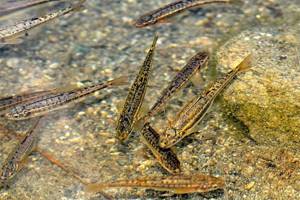
Habitat

The common minnow occupies the largest distribution area among all fish of this species. Habitat: Approximately all temperate regions of the world. For the most part it is found in reservoirs of more northern regions. The main habitats are lakes in river basins, reservoirs, small streams and cold rivulets. The minnow prefers clean, freshwater water. It lives mainly in small fast-flowing rivers, well-aerated reservoirs, on rocky rifts; they choose places near aquatic vegetation, densely located one above the other in several rows, with larger fish located closer to the bottom, smaller ones on top. Their numbers can be enormous. Due to the fact that the common minnow needs very clean, cool water with a high oxygen content, it does not live in dirty reservoirs. Those reservoirs where this species is preserved serve as a barometer of the ecological cleanliness of the reservoir. In reservoirs inhabited by predatory fish species, this fish serves as food.
The habitats of the lake minnow are often karst lakes, artificial reservoirs, quarries and peat bogs. It spends most of its life in the bottom layers, occasionally rising to the surface only in search of food.
It tolerates lack of oxygen in water without problems. This lively and attractive fish is not difficult to keep in a larger aquarium.
Amur minnow
This variety of minnow is larger in size than others. Its dimensions reach a length of up to 24 centimeters. This fish is one of the most abundant freshwater fish that lives in cold, fast-flowing semi-mountain rivers. The Amur minnow lives in places with a rocky bottom and a slightly slower flow, as well as in places where the bottom is silted and covered with vegetation.
This fish serves as food for many predatory fish. These are taimen, lenok, grayling and pike.
This species is quite widespread in the Amur River basin. Also, the Amur minnow in Primorye lives in the basin of the Razdolnaya River and in the rivers of the Sikhote-Alin slope (eastern side).
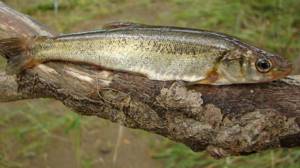
Diet
By nature of feeding, the fish is not picky. The basis of the diet are:
- scraps of diatoms and filamentous algae;
- plant organisms;
- insects and their larvae;
- worms;
- plankton;
- Daphnia and diatoms;
- carrion and juveniles.
They eat pollen from plants growing nearby in bodies of water, brought by wind and rain and deposited on the water. For a long time, schools of these fish lived near dams with water mills, feeding on flour dust.
When keeping them in aquariums, do not disdain any dry or frozen fish food.
Spawning
Puberty begins at two years of age. With the onset of warm weather, schools of fish return to their traditional habitats where spawning takes place. In the spawning flock, there are approximately two times fewer females than males. At the beginning of summer (from mid-May to the end of July), they begin spawning. The bravest males approach the female (and those females who are not yet ready run away) and begin to squeeze her from the sides. Spawning occurs and the eggs are immediately fertilized by other males. During the season, the female spawns up to a thousand eggs, laying them on rocky and pebble soils. The fertilized eggs adhere to the underside of the stones. The hatched larvae hide from the eggs between the stones until they begin feeding on their own. Closer to winter, in late autumn, they will bury themselves in the silt and spend the winter there. Life expectancy is approximately five years.
Fishing
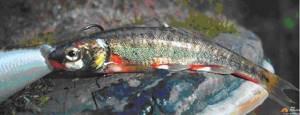
The common species has no commercial significance due to its small size and meat, which has a bitter taste. But once caught, no one throws it away, since it is an excellent bait for catching predatory fish: trout, pike-perch, perch.
The lake species is of commercial importance; it is larger and is consumed as food. It is widely used for preparing fish soup, it is suitable for frying and marinating, minced meat made from the meat of this fish is used for making cutlets, they turn out excellent.
Fishing
The minnow is not a serious fishing target. Due to the fact that these fish are very small, fishing enthusiasts pay little attention to them. For the most part, this fish is used as bait for catching predatory fish. Trout, pike, burbot, perch and chub bite on them.
Despite all of the above, there are anglers who go fishing specifically for minnows. They prefer to catch such small fish in order to feel the pleasure of the fishing process. This applies precisely to the case when fishing is part of an active recreation, and not an integral part of profit.
To catch minnows, it is better to use a float rod. The minnow does not bite at night, but it is excellent to catch in the morning and during the day. What do minnows bite on? It bites well on worms, maggots and house flies.
Often this fish is caught with nets or head over heels.
Minnow fishing
A distinctive feature of the two species under consideration is that the common minnow is caught along with other species, due to its small size, and the lake minnow is caught by fishermen on the shores of lakes and reservoirs for food.
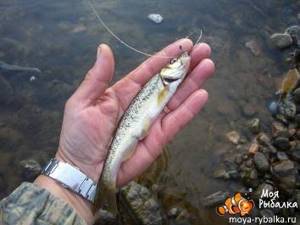
One of the methods of fishing is using a larger clay pot with holes drilled in the bottom and coated with dough on the sides from the inside. Another quick way of fishing is using an old bucket, in which small holes are made around the entire perimeter (this must be done so that water from the bucket, if necessary, is quickly removed), put a crust of bread on the bottom of the bucket and place the bucket in places of accumulation so that There was about half a meter of water above it. After half an hour, you can check the catch, which will serve as live bait for fishing.
Minnow bite
It bites vigorously throughout the day, excluding windy, cold days and rainy weather; it does not bite at night. Small fish gather at the surface of the water, more in the middle layers of the reservoir. You just have to focus exclusively on the places where he bites very well (not an easy task, but doable). The territory of successful fishing must be remembered, because it is never empty.
In late autumn, all species disappear, burrowing into silt for the winter.
How to catch?
When preparing for fishing, you need to choose the right rod with a slow action, super light class, and the smallest thin hooks. A thin hook cutting through the lip of a fish will not cause much damage to it. It is important to choose the optimal wiring. You can forget sudden jerks, only smoothness and ease of movement. For fishing, use the lightest equipment. When fishing at half-water or higher, hook it immediately, as it instantly swallows the caught bait and attacks without delay.
Fishing gear used:
- thin fishing lines;
- sinker-pellets;
- floats;
- light fishing rods (with good sensitivity), 4-5 meters long.

